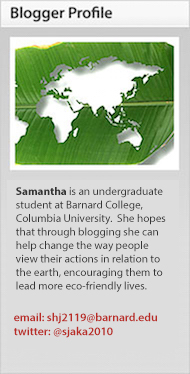« Prev Next »
If you are a parent of a young child, how would you feel if one day your child develops a nasty rash on their skin, scarring, and even blindness after accidentally coming into contact with a dangerous plant while playing outdoors? Well, recently in the news, warnings have gone out on the Northeast, in states such as New York, for a plant commonly known as Giant Hogweed. (Heracleum mantegazzianum) I am sure all of you are familiar with poison ivy and the unpleasant, itchy, rashes it leaves on you skin, but Giant Hogweed, in my opinion, is ten times as worse and severe.
Fun Fact: The Giant Hogweed got its scientific name from one of the world's most well known Greek hero, Hercules. Both Hercules and the Giant Hogweed are strong and immense.
So, what is Giant Hogweed?
Giant Hogweed originated in Asia. It was then transported to Great Britain, because people admired its flowers and used it for decoration. Eventually, it was shipped to gardens in America and Canada.
As mentioned in its name, Giant Hogweed is indeed a weed and it has the potential to grow more than 15 feet tall. Its leaves can even reach a width of 5 feet. Their stems are stained with purple spots and tiny white hairs grow on it. Since they are perennials, they come up every year, and when they are mature, they produce big, white, umbrella-like flowers. These flowers resemble the plant, Queen Anne's Lace, and some people also confuse it with Cow Parsnip. Therefore, many people do not recognize Giant Hogweed when they see it.
Giant Hogweed can produce tens of thousands of seeds per year, and by means of transportation, such as water, they are dispersed to new areas of land where they begin to grow. Therefore, the seeds can spread miles away from the mother plant. Eventually, they make their way into backyards, parks, and other outdoor spaces.
Health Effects
Giant Hogweed has become a major concern for parents and health officials. They are afraid that children might come across the plant at the park or in their backyard and play with it, not knowing the serious health effects. Not only are people vulnerable to the Giant Hogweed, but many animals, such as dogs, are victims of this noxious plant as well.
Giant Hogweed, unlike poison ivy, will not damage you skin or body if you brush against it. It is when you accidentally come into contact with the clear, liquid sap of the plant that your body is affected, especially if you are sweating and your skin is very moist. ( The sap can come from the broken leaves, roots, stems, or the flowers of the Giant Hogweed) Since Giant Hogweed gro ws outdoors, your will except to find a descent amount of sunlight. When the sunlight and the sap mix, chemicals from the sap, called furocoumarins, cause a phototoxic reaction to take place called phytophotodermatitis. This causes major blistering, rashes, and scarring that lasts for years. If a person touches his/her eyes, they can even go blind. The pain and effects are not sudden, but develop over a period of 3 days. Since the effects can be very brutal, it is listed on the federal noxious weed list.
ws outdoors, your will except to find a descent amount of sunlight. When the sunlight and the sap mix, chemicals from the sap, called furocoumarins, cause a phototoxic reaction to take place called phytophotodermatitis. This causes major blistering, rashes, and scarring that lasts for years. If a person touches his/her eyes, they can even go blind. The pain and effects are not sudden, but develop over a period of 3 days. Since the effects can be very brutal, it is listed on the federal noxious weed list.
Given that the sun is a main component in causing these health effects, people who get the sap on them should cover up the spot on their skin until they are out of the sun. Once inside, they should wash it with soap and cold water and call a doctor. People also have to be very careful to cover up the spot that was exposed to the sap for the following months in case another reaction occurs.
Ecological Effects
Giant Hogweed also affects the ecosystem. Since the plant is so large and requires a lot of resources, many other plants have to compete with it for space, sunlight, and water. Little by little, Giant Hogweed wins the competition for natural resources and causes the surrounding plants to slowly die out. Giant Hogweed is also known for causing erosion of soil because when they die, or hibernate for the winter, the soil is no longer patted down firmly in place.
In efforts to reduce the growing number of Giant Hogweed, many states are trying to wipe the population out. You can contact the Giant Hogweed Hotline by calling 845-256-3111 if you discover Giant Hogweed and they will come and exterminate it.( by means of herbicides or cutting the roots)
Photo Sources:
Picture Number 1: Antefixus21 (Via Flickr)
Picture Number 2: Kris Elshout (Via Flickr)
Sources:
David L. Marrison and David J. Goerig "Giant Hogweed" Ohio State University
"Giant Hogweed" Great Lakes Indian Fish and Wildlife Commission
"Giant Hogweed Biology" Department of Environmental Conservation
"Giant Hogweed Do Not Touch This Plant" Department of Environmental Conservation
"Giant Hogweed Identification" Department of Environmental Conservation
"Health Hazards and Safety Instructions for Giant Hogweed" Department of Environmental Conservation






















